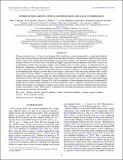| dc.contributor.author | Rykoff, Eli S. | |
| dc.contributor.author | Dupke, Renato A. | |
| dc.contributor.author | Mendes de Oliveira, Claudia | |
| dc.contributor.author | Lopes de Oliveira, Raimundo | |
| dc.contributor.author | Proctor, Robert N. | |
| dc.contributor.author | Garmire, Gordon P. | |
| dc.contributor.author | Koester, Benjamin P. | |
| dc.contributor.author | McKay, Timothy A. | |
| dc.contributor.author | Miller, Eric D | |
| dc.date.accessioned | 2015-02-20T19:55:28Z | |
| dc.date.available | 2015-02-20T19:55:28Z | |
| dc.date.issued | 2012-02 | |
| dc.date.submitted | 2011-05 | |
| dc.identifier.issn | 0004-637X | |
| dc.identifier.issn | 1538-4357 | |
| dc.identifier.uri | http://hdl.handle.net/1721.1/95468 | |
| dc.description.abstract | We report the discovery of 12 new fossil groups (FGs) of galaxies, systems dominated by a single giant elliptical galaxy and cluster-scale gravitational potential, but lacking the population of bright galaxies typically seen in galaxy clusters. These FGs, selected from the maxBCG optical cluster catalog, were detected in snapshot observations with the Chandra X-ray Observatory. We detail the highly successful selection method, with an 80% success rate in identifying 12 FGs from our target sample of 15 candidates. For 11 of the systems, we determine the X-ray luminosity, temperature, and hydrostatic mass, which do not deviate significantly from expectations for normal systems, spanning a range typical of rich groups and poor clusters of galaxies. A small number of detected FGs are morphologically irregular, possibly due to past mergers, interaction of the intra-group medium with a central active galactic nucleus (AGN), or superposition of multiple massive halos. Two-thirds of the X-ray-detected FGs exhibit X-ray emission associated with the central brightest cluster galaxy (BCG), although we are unable to distinguish between AGN and extended thermal galaxy emission using the current data. This sample representing a large increase in the number of known FGs, will be invaluable for future planned observations to determine FG temperature, gas density, metal abundance, and mass distributions, and to compare to normal (non-fossil) systems. Finally, the presence of a population of galaxy-poor systems may bias mass function determinations that measure richness from galaxy counts. When used to constrain power spectrum normalization and Ω [subscript m] , these biased mass functions may in turn bias these results. | en_US |
| dc.description.sponsorship | United States. National Aeronautics and Space Administration (Award 2834-MIT-SAO-4018) | en_US |
| dc.language.iso | en_US | |
| dc.publisher | IOP Publishing | en_US |
| dc.relation.isversionof | http://dx.doi.org/10.1088/0004-637x/747/2/94 | en_US |
| dc.rights | Article is made available in accordance with the publisher's policy and may be subject to US copyright law. Please refer to the publisher's site for terms of use. | en_US |
| dc.source | American Astronomical Society | en_US |
| dc.title | FINDING FOSSIL GROUPS: OPTICAL IDENTIFICATION AND X-RAY CONFIRMATION | en_US |
| dc.type | Article | en_US |
| dc.identifier.citation | Miller, Eric D., Eli S. Rykoff, Renato A. Dupke, Claudia Mendes de Oliveira, Raimundo Lopes de Oliveira, Robert N. Proctor, Gordon P. Garmire, Benjamin P. Koester, and Timothy A. McKay. “FINDING FOSSIL GROUPS: OPTICAL IDENTIFICATION AND X-RAY CONFIRMATION.” The Astrophysical Journal 747, no. 2 (February 21, 2012): 94. © 2012 The American Astronomical Society | en_US |
| dc.contributor.department | MIT Kavli Institute for Astrophysics and Space Research | en_US |
| dc.contributor.mitauthor | Miller, Eric D. | en_US |
| dc.relation.journal | The Astrophysical Journal | en_US |
| dc.eprint.version | Final published version | en_US |
| dc.type.uri | http://purl.org/eprint/type/JournalArticle | en_US |
| eprint.status | http://purl.org/eprint/status/PeerReviewed | en_US |
| dspace.orderedauthors | Miller, Eric D.; Rykoff, Eli S.; Dupke, Renato A.; Mendes de Oliveira, Claudia; Lopes de Oliveira, Raimundo; Proctor, Robert N.; Garmire, Gordon P.; Koester, Benjamin P.; McKay, Timothy A. | en_US |
| mit.license | PUBLISHER_POLICY | en_US |
| mit.metadata.status | Complete | |
